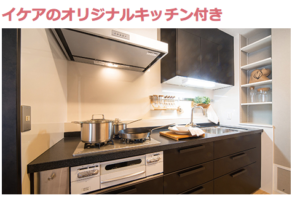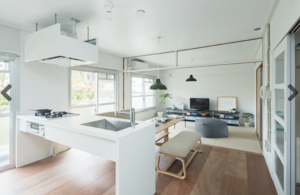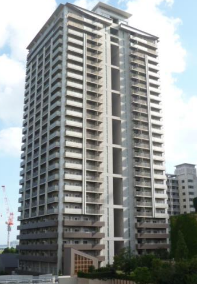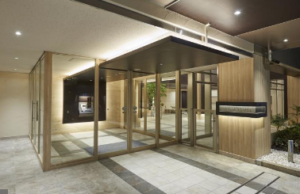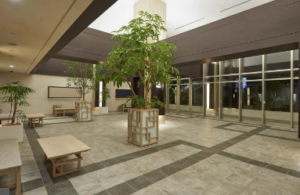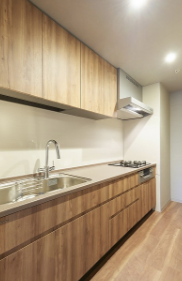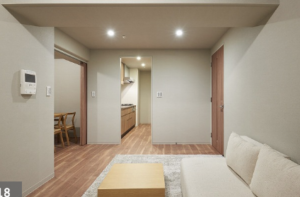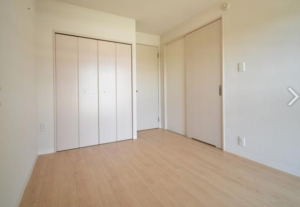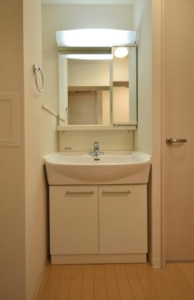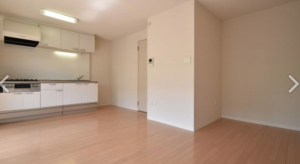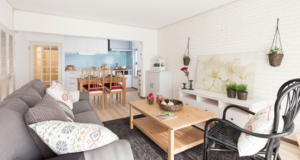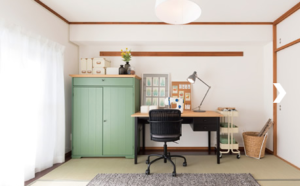(UR X IKEYA collaboration : IKEYA kitchen)
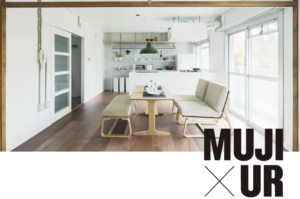
(UR X MUJI collaboration apartment in Kobe, Hyogo)
History and corporate structure of UR
It is worth knowing the background and character to deal with UR as they have started the operation as the government agency for housing.
Let me start with explaining the corporate structure and history of UR.
Their official name is ‘Urban Renaissance Agency’ (都市再生機構)and they are ’incorporated administrative agency’. (独立行政法人)
Officially speaking, they are not a part of the government organizations any more but still under the jurisdiction of
the Minister of Land, Infrastructure, Transport and Tourism (MLIT, 国土交通省)
All senior executives are amakudari from either cabinet office or MLIT.
Its capital is 107 billion yen and its number of employee is 3200.
Here is the brief history of UR.
Between 1975 and 1981
The organization provided housing and land through large-scale
development of new residential areas around major cities, which
were suffering from housing shortages due to high population and
industry concentration.
Representative projects include Chiba New
Town (Chiba Prefecture), Atsugi New Town (Kanagawa Prefecture)
and Izumi New Town (Osaka Prefecture).
*
The ironic truth is that those new towns built during the high economic growth time in 70s are now becoming the major source of akiya (abandoned houses, 空き家) as these condos (called ‘danchi’) are in rather suburban area where millennial generations are willing to reside.
These danchi are definitely still livable with the suitable renovation but buildings are getting outdated.
Between 1981 and 2004
Japan Housing Corporation and Land Development Corporation merged in 1981. The new company began providing apartment complexes and land with better living environments in large cities in urgent need of development, and undertook the redevelopment of cities by regenerating urban areas and urban parks.
After 2004
Urban Development Corporation and the Regional City Development Division of the Japan Regional Development Corporation merged into UR in 2004. The agency is striving to redevelop cities by making use of the technology and knowhow accumulated over more than half a century, and continues cooperating with private businesses to create cities where people can shine.
After UR was born, UR has been focusing on the providing housing loans with salary men and rental property business.
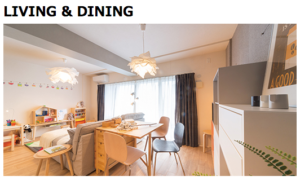
(UR X IKEYA collaboration apartment, Kobe)
UR’s mission
Mission: Promoting establishment of living environments responding to a diversity of generations, particularly the elderly
Providing housing that supports the extension of healthy life expectancy.UR furnishes living environments that motivate people to get out and around. Examples include home renovations that encourage movement by preventing falls, outdoor environments that invite people to go out for a walk, and a wealth of opportunities to pursue social interaction. The objective of these and other strategies is to support the extension of healthy life expectancy. New solutions introduced by UR include installation of bathroom heaters and floors that reduce coldness to the touch, as well as measures against heat shock.
● Entranceways: Doors that shut slowly, lighting fixtures that sense the presence of people, color schemes that prevent tripping on entrance rails, handrails, intercom systems with monitors
● Restrooms: Replacement of doorknobs with lever handles, exits/entrances with minimal height gaps, handrails in two locations
● Bathrooms: Handrails in three locations, bathtubs with low sides, bathroom heaters, floors that reduce coldness to the touch, folding doors that are easy to open from outside the bathroom
Establishing living environments for elderly households through, e.g., Mimamori services
With the demographic profile of tenants in UR rental accommodations rising rapidly, UR is implementing basic Mimamori services on a nationwide scale. Basing its approach on coexistence with measures currently implemented at the apartment-complex level, UR is implementing these services for all UR apartment complexes (except those in remote locations). UR is also making use of existing residences in UR rental apartment complexes to provide housing for the elderly that includes distributed services within each residential building, operated by private-sector enterprises.
UR rental housing stock E.g., raising the value of apartment complexes based on rejuvenation and reorganization
To rejuvenation and reorganize UR rental housing stock as valuable assets shared by everyone in Japan, UR laid down the “UR rental housing stock rejuvenation and reorganization policy” on December 26, 2007, to clarify the course of action to be taken by 2018. With the full-scale approaching of an aged society with falling birthrates, a decline in the population and number of households, and the need to play a central role in providing a housing safety net, while responding appropriately to changes in the social structure and business environment, we operate apartment complexes in a way that raises their value while ensuring their proper management as an incorporated administrative agency.
UR has around 742,000 apartment flats all over Japan but they are
mainly located in the three major economic zones such as Tokyo, Osaka and Nagoya.
Tokyo 167,280
Osaka 112,155
Chiba 88,539
Saitama 80,918
Kanagawa 73,914
Aichi 52,324
Hyogo 51,907
Fukuoka 45,867
Kyoto 23,492
Nara 14,996
(UR X MUJI collaboration apartment in Kobe)
Making use of the power to plan and convey information of private businesses and universities.Some good examples of collaboration with the private sector in boosting the quality of products are illustrated with MUJI and IKEYA.
-UR is renovating apartment complexes (MUJI x UR) by incorporating characteristics that allow “pleasant lifestyles,” as identified by a questionnaire survey carried out by MUJI, while retaining the desirable qualities of old apartment complexes.
-UR is running a “Letʼs live in a UR apartment flat with IKEA” project in which renovation is carried out, including even the kitchen and color coordination, in
collaboration with IKEA.
-Students of the Kyoto Womenʼs University came up with a proposal for an apartment flat that they wanted to live in, based on their
desire to think about the future of apartment complexes from the perspectives of young women and free thinking unique to students.
-Students of Nagoya City University, Nagoya Institute of Technology, and Nagoya Gakuin University are engaging in activities in which they are, for example, living and working in apartment complexes to train in providing home medical and care services.
*Please note UR X MUJI and UR X IKEYA collaboration properties look very nice but they are the mock up rooms.
Furnitures, carpets, curtains and dishes are not included.
Four advantages of UR rental property
1. No key money is required. (礼金なし)
Traditionally Japanese landlords ask their tenants to give the gift money(reikin, 礼金)at time of the contract.
It is a very strange custom but still alive.
You can negotiate with landlords but some will not give in.
UR don’t ask such reikin.
2. No brokerage commission is required. (仲介手数料なし)
Initial costs can be further saved.
3. No renewal fee (更新費用なし)
Again, traditionally tenants are asked to pay the renewal fee every two years. They usually charge you one month rent for renewal.
UR don’t charge the renewal fee.
4. No guarantor is required. (保証人必要なし)
Procedure of the application to rent.
– Find the room on the web site
If you have a favorite room, please contact us by phone or e-mail.
Information at the counter will also proceed smoothly. At UR stores, housing advisors will be able to help you find rooms based on your desired conditions
-Confirm application qualification
-Application (provisional application)
-Preview (Tenants must see the property within one week from the application)
– Submit contract documents (This process is for full and final application)
-Contract (contract date: within one week after submitting the document)
– Move in
The time from the provisional application to moving in process must be within 1 month therefore you need to move pretty quickly.
Here are the required qualification to rent UR property.
Foreigners with certain criteria can rent the property.
1. A person whose applicant’s average monthly income is over the standard monthly income
In case of applying with a family household
Monthly rent based on rent amount
Less than 82,500 yen Four times the rent amount
(Example) The standard monthly income of a dwelling unit with a rent of 60,000 yen is
It is 440,000 yen, 4 times the rent amount.
82,500 yen or more and less than 200,000 yen 330,000 yen (fixed amount)
200,000 yen or more 400,000 yen (fixed amount)
In case of applying as a single household
Monthly rent based on rent amount
Less than 62,500 yen Four times the rent amount
(Example) The standard monthly income of a dwelling unit with a rent amount of 50,000 yen is
It is 400,000 yen, four times the rent amount.
62,500 yen or more 200,000 yen or less 25,000 yen (fixed amount)
200,000 yen or more 400,000 yen (fixed amount)
2. For those who are Japanese nationals or who are qualified foreign nationals and require residence to continue to live in themselves
Requirement for foreign nationals
Those who can fully understand the contents of urban agency rental housing lease agreement, those who fall under any of the following qualifications are eligible.
1. Persons who are permanent resident, diplomatic, official (entrance control and refugee recognition law (Cabinet Order No. 319 of 1954, hereinafter referred to as “Immigration Act”) Article 22 paragraph 2 or Article 22-2 According to the provisions of paragraph 4)
2. Persons who are special permanent resident (Article 3, 4 and 5 of 1991 law relating to immigration control of persons who left Japanese nationality based on the Peace Treaty with Japan (Act No. 71 of 1991) According to the provision of.
3. Mid and long term residents (as prescribed in Article 19-3 of the Immigration Control Act)
close up
3. Single person or person who lives at the same time or has a relative who plans to live together
4. All persons living together, including applicant himself, are allowed to live within one month from the possibility of starting the tenancy determined by UR and be able to conduct a smooth shared life within the property
5. All persons living together, including the applicant himself, are not gang members.
Documents necessary for the provisional application
Application Form for Rental Housing Application (UR Urban Organization Designation Form)
Please fill in at the UR Sales Center
– Copy of resident card (住民票)
Those of the applicant and all living together relatives, with a description of the relationship are necessary. In addition, if you cannot confirm the relationship with the applicant himself / herself, you will also need a transcript of family register that you can check the relationship.
* Please submit the original (within 3 months old ) and not having the description of my number (personal number). In addition, since there is no mention of
* For foreign nationals, the subject matter may be omitted. When making a request for the issuance of a resident card, please fill in the application form that the following matters are necessary.
① Name (if common name is listed in resident card, name and common name)
② Date of birth
③ Gender
④ Head of household
⑤ Address
⑥ Nationality / Region
⑦ Date when you became a foreign resident
⑧ the fact that it is a middle- and long-term resident
⑨ Status of residence listed on residence card, period of stay, date of expiration of stay, number of residence card
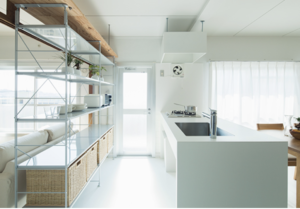
(UR X MUJI collaboration apartment in Kobe)
Documents certifying income
Required documents differ depending on your income form.
In addition, those who use “one-time payment system such as rent” do not need documents certifying income.
(1) Payroll income
* The documents of ① and ② are necessary.
① Withholding tax levy for the previous year
* Please submit the original (one with the seal stamped) and the one with no My Number (personal number) stated. In addition, if salary payment source is a sole proprietor, you will need to attach a stamp with a seal and a seal stamp certificate.
* If you do not meet one year after adoption, please use the income certificate of UR Urban Organization Designation Form.
At the same time, you will also submit a copy of your employee ID card and health insurance card.
② Tax certificate of this fiscal year or notice of inhabitant tax decision of this year
※ Please submit what the city municipalities publish last year’s income. Please submit the latest available thing during the period when tax certificate and resident’s tax decision notice for this fiscal year is not issued. The name may differ depending on the city, town or village.
(2) For individual business owners
Tax payment certificate for the previous year (Part 2)
* Please submit the original (issued by the director of the responsible tax office).
About handling personal information (My number)
Please be aware of the following points when submitting documents (withholding slip, resident card, etc.) that may contain personal numbers.
Documents necessary for contract (after you complete your full application)
UR rental housing will be entered after concluding a contract based on the lease contract stipulated by UR.
The items required at the time of contract are as follows.
– Lease agreement (Please fill in necessary items in advance.)
– Deposit money (equivalent to 2 months of monthly rent)
– Daily rent and monthly rent for the current month
– Certificate of sealed stamp (印鑑証明)and sealed stamp (within three months old) (For foreign nationals, “Certificate of signature” issued by consular office)
– ID (driver’s license or passport)
Here are some key rules when you live in UR property.
(1) Occupancy Date (入居日)
When taking up residence, you need to carry out the following procedures.
The date mentioned in your rental agreement when you are allowed to move in is called the permitted occupancy date. You are to take up residence within one month of this date. However, if you are unable to do so due to exceptional circumstances, you need to give the reason and the expected date of taking up residence on an “Application for Postponement of Taking up Residence” and submit it to the Administration service office or the administration contact. The period of postponement shall be no more than one month. Note that you are not allowed to enter the apartment for cleaning or moving belongings before the permitted occupancy date.
(2) Pets are not allowed. (ペットは禁止)
In ordinary apartment complexes, while there are no problems with keeping small birds and fish in a manner that does not disturb other residents, the ownership of other animals such as dogs, cats, pigeons, and chickens is prohibited.
Sounds and smells from these animals may not bother the owner, but they may disturb other people. Please ensure these rules are adhered to, for everyone’s convenience. Owners of animals that are prohibited within the apartment complex will be asked to rectify the situation, and in the event that no such action is taken, the owners will be asked to leave in order to maintain a pleasant living environment of the apartment complex. However, in accordance with the Assistance Dog Law, the usage of guide dogs, hearing dogs, medical assistance dogs, and other assistance dogs within the apartment complex is permitted, after submission of an application to UR. For details, please contact the Residence Center or other management facilities. In a number of designated houses in some apartment complexes, the cohabitation with pets is allowed. There are certain rules and regulations set for this purpose. For ensuring the comfortable life among residents including those who do not have pets, you are kindly requested to observe the rules and maintain the decent manners.
(3) Prohibition of Subletting or Unauthorized Use(サブリースは禁止)
Subletting or renting out all or part of your apartment is absolutely prohibited. Additionally, you are not allowed to use your apartment for taking lodgers or
purposes other than those stipulated in the rental agreement. (However, with the consent of UR, residents may use part of their apartment where it will help them in their work, i.e. in the case of child care support services, elderly support services, masseurs, or acupuncturists.) If UR becomes aware of infringements of the regulations, they will terminate your contract immediately and demand that you vacate the apartment as well as pay compensatory damages.
FAQ from UR web site
1) Internet connection
In order to provide a good Internet environment, UR is promoting IT conversion of UR rental housing.
There are also many properties that can be subscribed to the high-speed Internet connection environment by the in-building LAN method and the Internet service by the VDSL method, ADSL and CATV.
2) Earthquake protection
Most of UR rental houses are reinforced concrete or steel reinforced concrete.
In addition, the UR is promoting measures related to seismic diagnosis and seismic retrofitting of existing UR rental houses as necessary. In order to maintain the good function of the housing, UR will promptly implement emergency and high-importance repair each time, and we will continue to maintain and manage so that UR can live with peace of mind. For details, please check out the earthquake retrofit section.
3) Credit cards
UR does not accept credit card payment.
Payment of rent and common expenses(共益費) is requested by the method of automatic withdrawal (口座引き落とし)from an account at the financial institutions designated by UR.
3) Application by telephone
Application by the phone is not accepted.(Internet application is acceptable)
4) Other cost
UR does not charge any other cost apart from the deposit money(敷金) at time of the leasing contract such as fire insurance fee, key exchange fee and cleaning fee.
Tips when renting UR property
1) Some properties are super popular
I was once tying to rent a property in Asakusa because I wanted to live in Asakusa.
UR owns the very nice high rises including the one right in the center of Asakusa called
‘River Pier Azumabashi’’ (リバーピア吾妻橋)
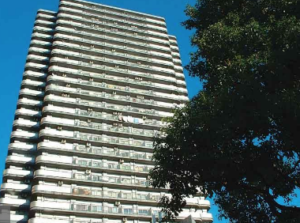
(River Pier Azumabashi in Asakusa, Sumida Ward)
However since it is located so nicely in Asakusa area with relatively young building age(built in 1989) and modern facilities,
apparently few tenants are terminating the lease contract.
I was told that the waiting list could last as long as five years.
There are other super popular properties that are located in central places such as Asakusa, Akihabara, Ebisu, Shinjuku, Nakameguro and Harumi and so on.
Please check with UR how realistic you can get such super popular properties.
(Harumi Island Triton Square Urban tower in Harumi in Chuo Ward)
2) Please go to their office after basic ground work on the internet
I have found that the information on UR web site is not updated on a
daily basis.
They have a lot of rooms to offer everyday.Some rooms change the tenants before they are put up on the web site once the notice by the current tenant is rendered.So it is always recommended to go to their office nearby and apply the preview on the spot and ask them if there are any rooms who are just opened.If you are interested in the particular property, please ask the sales woman if your hope is realistic first.If they believe, the property could be in theory become available every 3 months, ask them to put you on the waiting list.They don’t forget about you and will call you once the notice was given with certain rooms.
3) Don’t forget to ask the version of renovation standard
UR is developing new buildings but on average, UR buildings are very old and some of them are older that 40 years (You can find the age of the building on their web site).
However they are investing inside the rooms of old apartments more heavily and updating the facilities such as kitchens, bath rooms and toilets nicely.UR has 4 types of renovation standards and the latest version of their standard is called ‘renewal i’ As you can see in the pictures below, the layout is quite neat and over all facilities are reasonably modern (if not a plain cookie-cutter apartment)
You might want to select old properties purposefully to find newly renovated apartments.
The caveat is that the same property could have rooms with different version of the renovation standards therefore you need to ask the version of renewal standard about the room you are looking at.
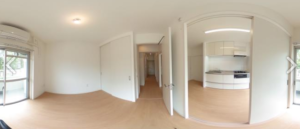
4) Timing matters
From the time you apply for the preview of the room to actual moving in must be within 1 month.It does not sound too rushing but if you required to book a moving company, arranging for the internet service for your new place and packing and so on, you don’t have much time.Landlords of private sectors are often flexible about the timing of the moving in, however UR is quite strict.Be prepared.
5) Rent matters
You would expect the competitive rent from UR ?
You will find the rent is well aligned with the market rate for most of UR properties.
But if you can find a apartment with recent renovation, your rent would be in the cheap range.
6) Don’t expect a classic feel or industrial vibes
UR apartments don’t combine modern design with a classic feel ! (except the newly built high rises)
UR official site (in Japanese)
UR X MUJI project (in Japanese)
UR X IKEYA project (in Japanese)
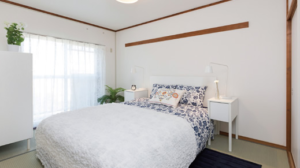
(UR X IKEYA collaboration apartment in Yokohama)
P.S.
UR offers the discounted rent for the properties where the former tenants have died.
It is called ‘jikobukken’ (事故物件)
If you are specifically looking for bargain rent (and you don’t care), UR could be a choice.
The rent for these apartments for first year is half price, after which it goes back to the original rent.
tokubetu boshu jutaku (特別募集住宅)
Toshihiko Yamamoto
Real estate investing consultant and author.
Toshihiko is currently writing a book about the real estate investing in Japan
for foreign investors. About the book
Founder of Yamamoto Property Advisory in Tokyo.
International property Investment consultant and licensed
real estate broker (Japan).
He serves the foreign companies and individuals to buy and sell
the real estates in Japan as well as own homes.
He holds a Bachelor’s degree in Economics from
Osaka Prefecture University in Japan
and MBA from Bond University in Australia

